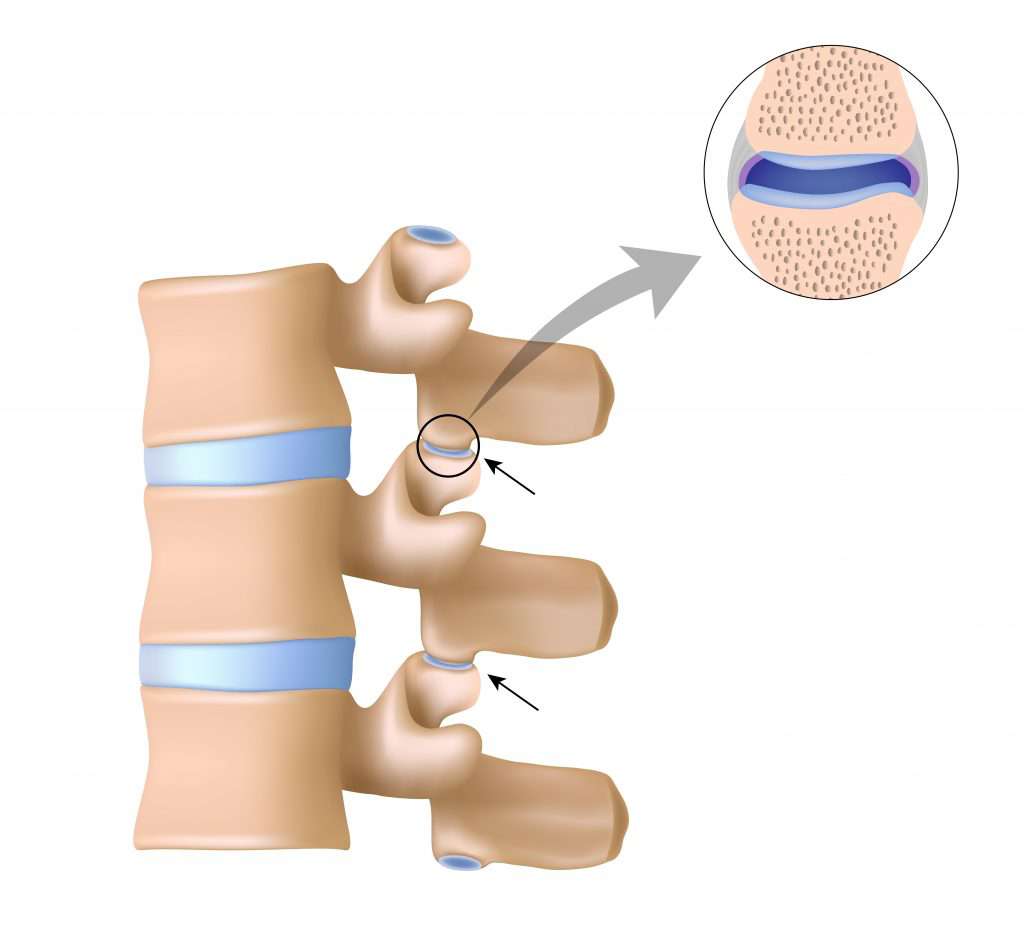
There are so many joints and bones in the spine it can be difficult to figure out what is what. The facet joint is the connection between the bones of the spine. As you can imagine, this is an incredibly important joint in the back. The facet joint keeps the bones of the spine together, while still allowing the spine to bend and twist. The joint is lined with cartilage and glide and slide when the back moves.
Think of the springs in your mattress; after a few years you are going to need to replace either the springs or the mattress itself. The springs will eventually get worn down after years of sleeping on your mattress. The same principle is true of the facet joints in your back. They will wear down after years of living a good life. Unfortunately, replacing your back is not as easy as replacing your mattress. Most patients need to figure out a way to fix the springs in their back, aka the facet joint.
Facet Joint Syndrome
Facet joint syndrome generally occurs when the cartilage begins to breakdown and becomes inflamed. Instead of a smooth cartilage, the cartilage will become jagged and bumpy. Facet joint syndrome is a contributing factor in more than 50% of patients with back pain. Fixing the facet joint can relieve patient’s back pain and immensely improve their quality of life.
Patients with facet joint syndrome have difficulty bending and twisting as their facet joints. Simple movements, such as bending forward and turning their back around may result in severe pain. If you are a golfer, then getting out on the golf course will nearly be impossible. Treatment methods have mixed results for patients.
You can also read: WHAT ALTERNATIVES DO I YOU HAVE TO SI JOINT FUSION?
Facet Joint Treatments
Patients with facet joint syndrome are often left with only a few treatment options that may not be successful depending on the patient. Some first treatment methods that are recommended are physical therapy, fixing posture, and inflammatory medication. If patients do not respond to conservative treatments then more drastic measures need to be taken.
Steroid injections are often a treatment method that is used to treat facet joint syndrome. This can provide short-term relief to patients. The anti-inflammatory effects of steroid injections can provide relief to patients who are in serious pain from facet joint syndrome. The problem is that steroid injections often are harmful to cartilage over a long period of time. There are several studies that prove that patients who are given steroid injections are actually worse off than if there was no intervention at all.
Another treatment method patients are treated with is rhizotomy. The nerve endings in the facet joint are burned off so that the patient does not feel any pain. That will work for some patients, but if the injury is severe enough that it is limiting their quality of life then it is not a solution.
Surgery is considered a last resort for patients who cannot find any type of relief for their facet joint pain. The vertebrae in the back are fused together in this surgery so that the back does not need to use the facet joint that is causing the issues. This type of surgery will probably help the facet joint that is currently under duress. The issue with surgery is that it could lead to more long-term issues with the patient’s back and spine. The fusion will push all of the force that the facet joint was absorbing and transfer it to the facet joint either above or below the original joint. That could eventually lead to facet joint syndrome in other facet joints in the back. It seems that whichever treatment option patients choose, they will not be able to solve facet joint syndrome.
Patients now have a new option when it comes to facet joint syndrome. Stem cell therapy is a new, innovative treatment that could potentially change the way the medical industry treats facet joint syndrome.
You might be interested: HIP LABRAL TEAR RECOVERY TIME WITHOUT SURGERY
Stem Cell Therapy
Stem cells are a relatively new treatment method for patients with facet joint syndrome. The treatment has shown great promise with many other back ailments, which is why researchers are interested in utilizing stem cells for facet joint syndrome. Stem cells have the ability to completely repair the cartilage in a facet joint. They utilize the body’s natural healing processes and create new cartilage in the joint as well as revitalize the old cartilage.
There is a study underway that is looking at treating the facet joint with stem cells. The study is going to take 40 patients who are currently suffering from facet joint syndrome. The main goal of the study is to showcase that stem cell therapy is safe for patients, but a secondary goal of the study is to evaluate the effectiveness of the treatment.
The stem cells will be injected into the facet joints that are experiencing the pain of 20 patients.
The control group will receive a steroid injection instead of the stem cell injection. This will also provide relief to patients, but as we know it will not repair the actual injury. There is a good chance that the stem cell therapy will provide a long-term solution for patients and they can avoid surgery as well.
The study is not going to be completed until April 2020 so keep your ear to the ground to hear more about the study. If the treatment is proved to be safe, then this study will lay the groundwork for stem cell therapy to be a bonafide treatment for facet joint syndrome.
Stem cells will give patients who have been suffering from facet joint syndrome a new lease on life. Patients should discuss all potential treatment options with their medical professional. Avoiding surgery would be a huge benefit for patients with facet joint syndrome.


